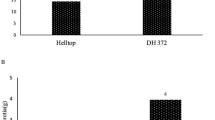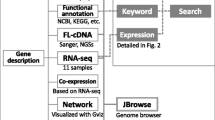Abstract
The great progress has been made in rubber tree breeding, but the molecular mechanisms underlying high yield are not well understood. Here, we reported the sequencing, assembly, and comparative analyses of latex transcriptome from two rubber tree varieties. In total, 33,852 unigenes were generated with de novo assembly. The blastx results indicated that 27,886 and 15,704 unigenes showed significant similarities to known proteins from NCBI nr and Swissprot databases, respectively. Among these annotated unigenes, 21,841 and 9010 ones were separately assigned to Gene Ontology (GO) functional categories and Clusters of Orthologous Groups (COGs). Of 126 KEGG pathways, metabolic pathway was the biggest one, suggesting that active metabolic processes happen in rubber tree latex. In contrast to RRIM 600, 2513 and 1391 genes were separately up- and downregulated in RY 7-20-59. The expression profiles of 25 unigenes were further confirmed by real-time RT-PCR, suggesting that the differently expressed genes (DEGs) identified by RNA-seq were accurate and reliable in this study. The DEGs between RRIM 600 and RY 7-20-59 were significantly enriched in plant-pathogen interactions, phenylpropanoid biosynthesis, phenylalanine metabolism, ubiquinone and other terpenoid-quinone biosynthesis, biosynthesis of secondary metabolites, and photosynthesis. Interestingly, the genes involved in rubber biosynthesis pathway, such as CPT, GPPS, HMGR, HMGS, FPPS and DXS, were differently expressed between RRIM 600 and RY 7-20-59. It was the first time that the latex transcriptomes of two rubber tree varieties have been compared and analyzed on a transcriptome-wide scale. Our results not only enrich the transcriptome data of rubber tree but also provide new insights into understanding latex transcriptome and molecular mechanisms underlying high yielding in rubber tree.






Similar content being viewed by others
References
Asawatreratanakul K, Zhang YW, Wititsuwannakul D et al (2003) Molecular cloning, expression and characterization of cDNA encoding cis-prenyltransferases from Hevea brasiliensis. A key factor participating in natural rubber biosynthesis. Eur J Biochem 270:4671–4680
Bindea G, Mlecnik B, Hackl H et al (2009) ClueGO: a cytoscape plug-in to decipher functionally grouped gene ontology and pathway annotation networks. Bioinformatics 25:1091–1093
Cataldo F (2000) Guayule rubber: a new possible world scenario for the production of natural rubber. Prog Rubber Plast Technol 16:31–59
Chappell J (1995) Biochemistry and molecular biology of the isoprenoid biosynthetic pathway in plants. Annu Rev Plant Physiol Plant Mol Biol 46:521–547
Chow KS, Mat-Isa MN, Bahari A et al (2012) Metabolic routes affecting rubber biosynthesis in Hevea brasiliensis latex. J Exp Bot 63(5):1863–1871
Chow KS, Wan KL, Isa MNM et al (2007) Insights into rubber biosynthesis from transcriptome analysis of Hevea brasiliensis latex. J Exp Bot 58(10):2429–2440
Chye ML, Tan CT, Chua NH (1992) Three genes encode 3-hydroxy-3-methylglutaryl-coenzyme A reductase in Hevea brasiliensis: hmg1 and hmg3 are differentially expressed. Plant Mol Biol 19:473–484
Cornish K (2001) Similarities and differences in rubber biochemistry among plant species. Phytochemistry 57:1123–1134
d’Auzac J, Jacob JL, Prévôt JC et al (1997) The regulation of cis-polyisoprene production (natural rubber) from Hevea brasiliensis. In: Pandalai SG (ed) Recent research developments in plant physiology. Research Singpost, Trivandrum, pp 273–332
Dennis MS, Light DR (1989) Rubber elongation factor from Hevea brasiliensis. J Biol Chem 264:18608–18617
Eveland AL, Satoh-Nagasawa N, Goldshmidt A et al (2010) Digital gene expression signatures for maize development. Plant Physiol 154:1024–1039
Garber M, Grabherr MG, Guttman M, Trapnell C (2011) Computational methods for transcriptome annotation and quantification using RNA-Seq. Nat Methods 8:469–477
Grabherr MG, Haas BJ, Yassour M et al (2011) Full-length transcriptome assembly from RNA-Seq data without a reference genome. Nat Biotechnol 29:644–652
Hepper CM, Audley BG (1969) The biosynthesis of rubber from β-hydroxy-β-methylglutaryl-coenzyme A in Hevea brasiliensis latex. Biochem J 114:379–386
Huang HS (2005) Rubber tree elite clones. In: Huang HS (ed) Fifty years of rubber tree breeding in China. China Agriculture Press, Beijing, pp 145–148
Huang HS, Fang JL, Zhuo SC, Tian L, Tan DG (2000) Selection and breeding of potential rubber clone SCATC 7-20-59. Chin J Trop Crops 21(2):1–6
Huang X, Madan A (1999) CAP3: a DNA sequence assembly program. Genome Res 9:868–877
Huang ZD, Pan YQ (1992) Rubber cultivation under climatic stresses in China. In: Sethuraj MR, Mathew NM (eds) Natural rubber: biology, cultivation and technology. Elsevier Science Publishers BV, Amsterdam, pp 220–238
Kanehisa M, Goto S (2000) KEGG: kyoto encyclopedia of genes and genomes. Nucleic Acids Res 28:27–30
Kim D, Pertea G, Trapnell C, Pimentel H, Kelley R, Salzberg SL (2013) TopHat2: accurate alignment of transcriptomes in the presence of insertions, deletions and gene fusions. Genome Biol 14:R36
Li B, Dewey CN (2011) RSEM: accurate transcript quantification from RNA-Seq data with or without a reference genome. BMC Bioinforma 12:323
Li DJ, Deng Z, Chen CL et al (2010) Identification and characterization of genes associated with tapping panel dryness from Hevea brasiliensis latex using suppression subtractive hybridization. BMC Plant Biol 10:140
Li DJ, Deng Z, Qin B, Liu XH, Men ZH (2012) De novo assembly and characterization of bark transcriptome using Illumina sequencing and development of EST-SSR markers in rubber tree (Hevea brasiliensis Muell. Arg.). BMC Genomics 13:192
Li W, Godzik A (2006) Cd-hit: a fast program for clustering and comparing large sets of protein or nucleotide sequences. Bioinformatics 22:1658–1659
Mortazavi A, Williams BA, McCue K, Schaeffer L, Wold B (2008) Mapping and quantifying mammalian transcriptomes by RNA-Seq. Nat Methods 5(7):621–628
Oh SK, Kang H, Shin DH et al (1999) Isolation, characterization, and functional analysis of a novel cDNA clone encoding a small rubber particle protein from Hevea brasiliensis. J Biol Chem 274:17132–17138
Post J, van Deenen N, Fricke J et al (2012) Laticifer-specific cis-prenyltransferase silencing affects the rubber, triterpene, and inulin content of Taraxacum brevicorniculatum. Plant Physiol 158:1406–1417
Priya P, Venkatachalam P, Thulaseedharan A (2007) Differential expression pattern of rubber elongation factor (REF) mRNA transcripts from high and low yielding clones of rubber tree (Hevea brasiliensis Muell. Arg.). Plant Cell Rep 26:1833–1838
Priyadarshan PM, Goncalves PS, Omokhafe KO (2009) Breeding Hevea rubber. In: Mohan JS, Priyadarshan PM (eds) Breeding plantation tree crops: tropical species. Springer Science + Business Publishing, New York, pp 469–522
Rahman AY, Usharraj AO, Misra BB et al (2013) Draft genome sequence of the rubber tree Hevea brasiliensis. BMC Genomics 14:75
Salgado LR, Koop DM, Pinheiro DG et al (2014) De novo transcriptome analysis of Hevea brasiliensis tissues by RNA-seq and screening for molecular markers. BMC Genomics 15:236
Sando T, Takaoka C, Mukai Y et al (2008) Cloning and characterization of mevalonate pathway genes in a natural rubber producing plant, Hevea brasiliensis. Biosci Biotechnol Biochem 72:2049–2060
Severin AJ, Woody JL, Bolon YT et al (2010) RNA-Seq atlas of Glycine max: a guide to the soybean transcriptome. BMC Plant Biol 10:160
Tang C, Xiao X, Li H et al (2013) Comparative analysis of latex transcriptome reveals putative molecular mechanisms underlying super productivity of Hevea brasiliensis. PLoS ONE 8(9), e75307
Triwitayakorn K, Chatkulkawin P, Kanjanawattanawong S et al (2011) Transcriptome sequencing of Hevea brasiliensis for development of microsatellite markers and construction of a genetic linkage map. DNA Res 18(6):471–482
Venkatachalam P, Thanseem I, Thulaseedharan A (1999) A rapid and efficient method for isolation of RNA from bark tissues of Hevea brasiliensis. Curr Sci 77:635–637
Wang L, Feng Z, Wang X, Wang X, Zhang X (2010) DEGseq: an R package for identifying differentially expressed genes from RNA-Seq data. Bioinformatics 26:136–138
Wang Z, Gerstein M, Snyder M (2009) RNA-Seq: a revolutionary tool for transcriptomics. Nat Rev Genet 10:57–63
Xia Z, Xu H, Zhai J, Li D, Luo H, He C, Huang X (2011) RNA-Seq analysis and de novo transcriptome assembly of Hevea brasiliensis. Plant Mol Biol 77(3):299–308
Xu H, Gao Y, Wang J (2012) Transcriptomic analysis of rice (Oryza sativa) developing embryos using the RNA-seq technique. PLoS ONE 7(2), e30646
Zhang G, Guo G, Hu X et al (2010) Deep RNA sequencing at single base-pair resolution reveals high complexity of the rice transcriptome. Genome Res 20:646–654
Acknowledgments
This research was supported by the National Natural Science Foundation of China (31200514, 31270651 and 30960310), Fundamental Research Funds for Rubber Research Institute, CATAS (1630022015003), and National Program on Key Basic Research Project of China (2012CB723005). We would like to thank Beijing Genomics Institute (Shenzhen) for assistance with the raw data processing and bioinformatics analyses.
Data Archiving Statement
The assembled sequences and sequence reads were separately submitted to the NCBI Transcriptome Shotgun Assembly (TSA) and Sequence Read Archive (SRA) database, and the accession numbers of TSA and SRA were GBHP00000000 and SRP044081, respectively.
Author information
Authors and Affiliations
Corresponding author
Additional information
Communicated by J. L. Wegrzyn
This article is part of the Topical Collection on Gene Expression
Dejun Li and Lili Hao contributed equally to this work.
Rights and permissions
About this article
Cite this article
Li, D., Hao, L., Liu, H. et al. Next-generation sequencing, assembly, and comparative analyses of the latex transcriptomes from two elite Hevea brasiliensis varieties. Tree Genetics & Genomes 11, 98 (2015). https://doi.org/10.1007/s11295-015-0928-0
Received:
Revised:
Accepted:
Published:
DOI: https://doi.org/10.1007/s11295-015-0928-0




